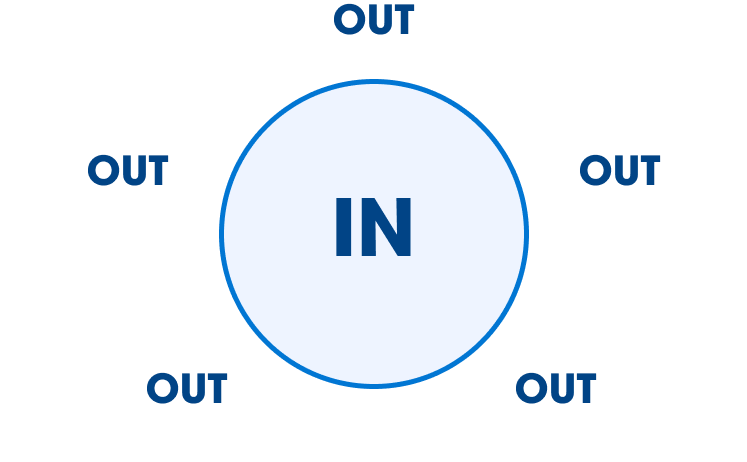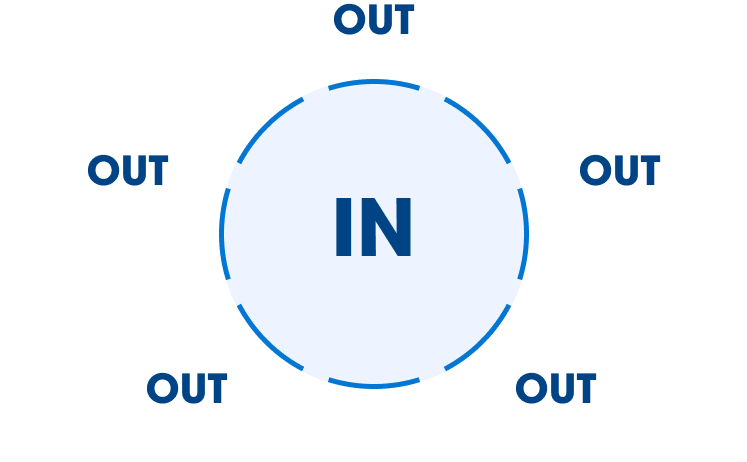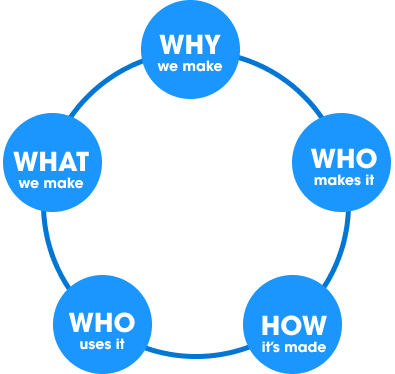Interrupt the Cycle of Exclusion
Learning Objectives
After completing this unit, you’ll be able to:
- Discuss the shut-in-shut-out model of exclusion.
- Describe the five elements of the cycle of exclusion.
- Define exclusion habits.
Shut In, Shut Out
In the last unit, we talked about how everyone knows what it feels like to be left out and how exclusion can affect our sense of belonging. Now, we’re going to dig a little deeper into how our habits in the design process can perpetuate exclusion. We’ll also talk about a framework we can use to shift those habits.
First, let’s do a quick vocabulary lesson. The English words for “include” and “exclude” are related to the Latin word claudere (sounds like clow-day-ray), which means “to close or shut.” Inclusion is to shut in, and exclusion is to shut out. If we were to represent shut in and shut out, we might use a closed circle, with the “in” group inside the circle and the excluded group on the outside. This is what’s called the shut-in-shut-out model of exclusion.

A shut-in-shut out model of exclusion is centuries old and leads to a fixed way of thinking about inclusion.
It seems simplistic, but the shut-in-shut-out model appeals to society’s basic instinct to protect whatever it is we want to preserve–such as power, people, things, status, and more. Good or bad, it’s human nature to want to shut out the influences that may affect the dynamics of the status quo. Because this exclusion model has existed for centuries, it has, as a result, informed how cultures interpret inclusion.

Cycle of Exclusion
Exclusion can happen at any point in the design process. Because the design of a product or solution evolves over time, exclusion also happens in cycles. For example, a company could decide to refresh its website and change the colors. But if it does so without considering the potential consequences, the design choices may suddenly render the site inaccessible to people who have color blindness. So if design choices aren’t fixed, then neither is exclusion.
Let’s shift our focus away from the fixed perspective of the shut-in-shut-out model to a different framework: the cycle of exclusion. What leads to a cycle of exclusion are the incorrect assumptions designers make about people. Using the cycle of exclusion, we can better examine mismatches (which are the building blocks of exclusion) and identify the habits that perpetuate exclusion.
There are five interrelated elements to the cycle of exclusion.
- Why we make: The motivations of the problem solver.
- Who makes it: The problem solver.
- How we make: The methods and resources the problem solver uses.
- Who uses it: The assumptions the problem solver makes about the people who use the solution.
- What we make: The solution or product that the problem solver creates.

Exclusion Habits
Now that we have a framework, let’s put it to work. The elements of the cycle of exclusion are questions we can ask during the design process. For example, you’ve likely experienced a public restroom where you have to wave your hand at a sensor to trigger the flushing mechanism. But what if you can’t see the sensor or you don’t have a hand to wave? Had the designers had the right exclusion experts to help create a solution that makes sense for people of all abilities, flushing this type of toilet wouldn’t be a dehumanizing experience for some people.
When we use the cycle of exclusion to ask questions, we interrupt the autopilot nature of our exclusion habits. Exclusion habits are any design practices or choices that lead to or perpetuate exclusion. An example might be organizing information on a webpage in a way that fits our preferred language or learning style. They’re hard habits to break, because we often believe we don’t have the power to make changes. As a result, we don’t hold ourselves accountable for shifting to inclusion practices. But, once we interrupt our exclusion habits–and thus the cycle–we can then provide the space for identifying mismatches and figuring out ways to resolve them.
Risk of a Hero Complex
A common pitfall to avoid is wanting to be the hero who saves the day with a design. Yes, great design can have a meaningful impact and you may even be called a superhero for creating it. But making assumptions about what products or solutions a group might need will likely lead to trouble.
Take the following example. In 2012, a pen company launched a series of pens for women that claimed to accommodate a woman’s hands with a smaller barrel and soft, pastel colors? The product left customers wondering how many women had contributed to the process of making and marketing these pens. A design is successful only when the user of that design confirms it has achieved its purpose. After thousands of scathing reviews from people who felt patronized and mischaracterized, let’s just say the launch failed miserably. The product team had based their design on stereotypes and incorrect assumptions–perhaps that women can’t hold regular-sized pens and needed help. The moral of the story is: Don’t be a hero.
The work it takes to implement inclusive design practices, for sure, can be complex and nonsequential. It takes a lot of work and requires buy-in from people who are most likely going to feel excluded or alienated by a product. You have to start at whatever point makes sense for your situation. Let’s be exclusion busters!
